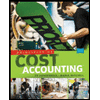1. Managers who analyze the difference between expected and actual performance in order to make improvements in future operations are following which step of the decision-making process? A. Identify the problem with uncertainties. B. Obtain information. C. Make predictions about the future. D. Make decisions by choosing among alternatives. E. Implement the decision, evaluate performance, and learn. 2. When do managers typically review and update the budgeted direct cost rate? A. Annually B. Monthly C. Quarterly D. Semi-annually E. Daily 3. Which of the following is not a characteristic of a manager using a job-order costing system? A. The cost object is a unique job or batch of products. B. Costs are assigned to specific products or services. C. Cost object is masses of identical or similar units of a product. D. Uses a job-cost sheet to track the costs of a specific job. E. Per-unit costs are determined for each distinct product or service.
1. Managers who analyze the difference between expected and actual performance in order to make improvements in future operations are following which step of the decision-making process? A. Identify the problem with uncertainties. B. Obtain information. C. Make predictions about the future. D. Make decisions by choosing among alternatives. E. Implement the decision, evaluate performance, and learn. 2. When do managers typically review and update the budgeted direct cost rate? A. Annually B. Monthly C. Quarterly D. Semi-annually E. Daily 3. Which of the following is not a characteristic of a manager using a job-order costing system? A. The cost object is a unique job or batch of products. B. Costs are assigned to specific products or services. C. Cost object is masses of identical or similar units of a product. D. Uses a job-cost sheet to track the costs of a specific job. E. Per-unit costs are determined for each distinct product or service.
Chapter7: Budgeting
Section: Chapter Questions
Problem 4MC: Which approach is most likely to result in employee buy-in to the budget? A. top-down approach B....
Related questions
Question
Please solve this General accounting questions step by step

Transcribed Image Text:1. Managers who analyze the difference between expected and actual performance in order to
make improvements in future operations are following which step of the decision-making
process?
A. Identify the problem with uncertainties.
B. Obtain information.
C. Make predictions about the future.
D. Make decisions by choosing among alternatives.
E. Implement the decision, evaluate performance, and learn.
2. When do managers typically review and update the budgeted direct cost rate?
A. Annually
B. Monthly
C. Quarterly
D. Semi-annually
E. Daily
3. Which of the following is not a characteristic of a manager using a job-order costing
system?
A. The cost object is a unique job or batch of products.
B. Costs are assigned to specific products or services.
C. Cost object is masses of identical or similar units of a product.
D. Uses a job-cost sheet to track the costs of a specific job.
E. Per-unit costs are determined for each distinct product or service.
Expert Solution
This question has been solved!
Explore an expertly crafted, step-by-step solution for a thorough understanding of key concepts.
Step by step
Solved in 2 steps

Recommended textbooks for you

Principles of Accounting Volume 2
Accounting
ISBN:
9781947172609
Author:
OpenStax
Publisher:
OpenStax College

Excel Applications for Accounting Principles
Accounting
ISBN:
9781111581565
Author:
Gaylord N. Smith
Publisher:
Cengage Learning

Managerial Accounting: The Cornerstone of Busines…
Accounting
ISBN:
9781337115773
Author:
Maryanne M. Mowen, Don R. Hansen, Dan L. Heitger
Publisher:
Cengage Learning

Principles of Accounting Volume 2
Accounting
ISBN:
9781947172609
Author:
OpenStax
Publisher:
OpenStax College

Excel Applications for Accounting Principles
Accounting
ISBN:
9781111581565
Author:
Gaylord N. Smith
Publisher:
Cengage Learning

Managerial Accounting: The Cornerstone of Busines…
Accounting
ISBN:
9781337115773
Author:
Maryanne M. Mowen, Don R. Hansen, Dan L. Heitger
Publisher:
Cengage Learning

Principles of Cost Accounting
Accounting
ISBN:
9781305087408
Author:
Edward J. Vanderbeck, Maria R. Mitchell
Publisher:
Cengage Learning